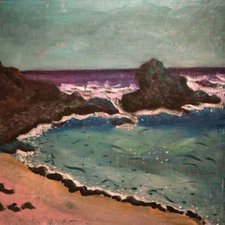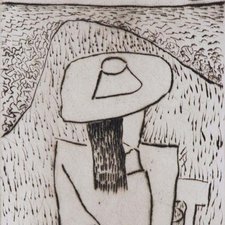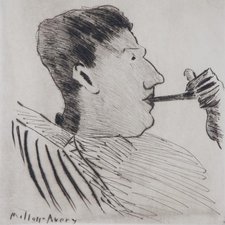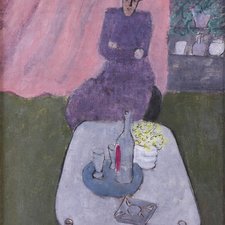Milton Avery
1885 - 1965
Milton Avery first visited Gloucester in 1920 and returned frequently during the summer through 1945. In 1924 he met the young art student Sally Michel in Gloucester, and the two married soon after. The Avery's friends Adolf Gottlieb, Mark Rothko and Barnett Newman joined them in Gloucester in 1932. The Rothkos visited them a second time on Cape Ann in 1934. Avery's art underwent a dramatic change during his years on Cape Ann. In the 1920s his work reflected the influence of Impressionism and John Twachtman. Gradually, he began to introduce the simplified shapes, flattened forms and solid areas of color, which typified his mature work.
Discussions in the Avery household revolved around the notion that a painting should be flat and lie on one plane rather than evoke what Avery called photographic depth. He championed simplified, precisely delineated forms and flattened color masses when few were willing to listen. Perhaps Avery's greatest legacy was his ability to abstract the mood of a place or situation with color.
... at the core of his approach to painting was a single firm rule: never invent imagery. He would simplify, flatten, distort, or chromatically abstract a landscape, portrait, or interior, but he never introduced elements into the composition, which did not exist in the physical world. He would not invent what was not there.
—Barbara Haskell, Milton Avery, NY: Whitney Museum of American Art, 1982
We were followers of the sea. On the beaches of Provincetown, Gloucester and Gaspe we braved the surf and rocky shore, spending endless hours contemplating the sea... Always the sea beckoned, at times with figures, at times with boats. But it was the sea, alternately black and mysterious or ruddy and gay that expressed the mystery and independence that makes its lure unfathomable. For Milton this was a subject to challenge again and again.
—Sally Michel Avery, "Avery and the Sea," Milton Avery. Seascapes, Grace Borgenicht Gallery, January 1987
Avery is first a great poet. His is the poetry of sheer loveliness, of sheer beauty. Thanks to him this kind of poetry has been able to survive in our time...
There have been several others in our generation who have celebrated the world around them, but none with that inevitability where the poetry penetrated every pore of the canvas to the very last touch of the brush. For Avery was a great poet-inventor who had invented sonorities never seen nor heard before.
—Mark Rothko, "Memorial Address," New York Society for Ethical Culture, January 7, 1965




